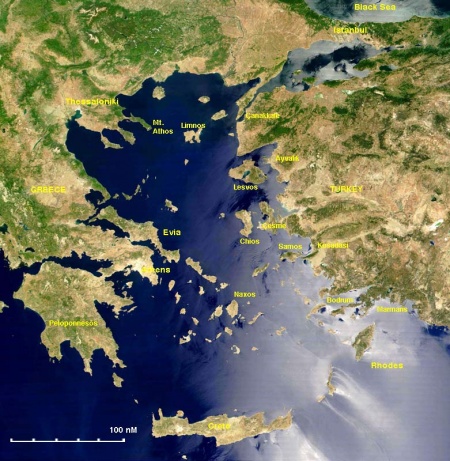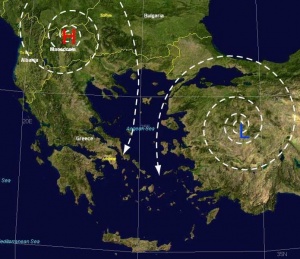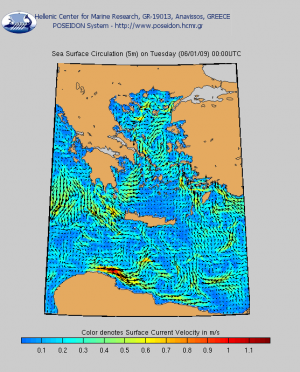Aegean Sea
From CruisersWiki
Contents |
AEGEAN SEA CRUISING GUIDE
An online cruising guide for yachts sailing in the Aegean Sea.
Background
The Aegean Sea is not only the cradle of western civilization but also one of the world's premier cruising regions because of its many anchorages for sailing yachts, and historical sites.
The Aegean Sea cruising region has an area of 214,000 km2. Its north-south axis is 330 nM and its east-west axis 162 nM. Other then its Greek and Turkish shore-lines, it consists of 1,415 islands and islets most of them belonging to Greece. It is a deep sea with a maximum depth of 3,543 m (11,624 ft).
The history of the Aegean goes back to Neolithic times when obsidian artifacts (knives, razors, spears, etc.) were made in the island of Milos. By 4000 BC Neolithic colonists were living on Crete and most of the Cyclades where an advanced civilization started to develop, the Cycladic Civilization ushering in the Bronze Age. These were the people who built a wealthy town in Akrotiri, Santorini with its magnificent fresco paintings. On Crete a new seafaring civilization, the Minoan flourished (2000-1450 BC) with its marvelous palaces, paintings, advanced plumbing, and vases. By 1500 BC a new civilization emerged on the Greek mainland, the Myceneans who spoke an early version of Greek, kept records on clay tablets, built palaces, traded with the Egyptians to the south and the Phoenicians to the east. In either the 12th or 11th century BC the Mycenaeans, also known as the Aecheans, invaded Troy. The Trojan War became part of the Greek oral tradition and was told by many bards. One of them, Homer, wrote his famous epic poems the Iliad, describing the last year of the war, and the Odyssey describing the travails of the return of the hero Odysseus from Troy to his native Ithaca.
The Mycenaeans were supplanted by the Dorians, Greek speaking people who came from the north. They brought the Iron Age to the Aegean and were the ancestors of the Spartans. Following this invasion the Aegean region lapsed into a decline which has been labeled the “Dark Age.” It lasted from 1150 to 800 BC.
The period between 750 to 480 BC is known as the Archaic Period. During this time many of the historical Greek city-states (polis) developed and established many colonies along the Asian Aegean coast, democracy was invented in Athens, poetry (Hesiod, Homer, Alcaeus, Sappho, Corinna), philosophy and the sciences (Pythagoras, Anaximander, Thales) flourished. In the east the Lydians and the Carians were first invaded by the Assyrians, Babylonians, and then the Persians. The latter made two invasions onto Greece. The first ended by the amazing Athenian victory of the Battle of Marathon at 490 BC. The second invasion, ten years later, led by the Persian “King of Kings” Xerxes resulted in the slaughter of the Spartan king Leonidas at Thermopilae, the destruction of Athens, and against great odds the total defeat of the Persian navy at the Battle of Salamis in 480 BC, and the rout of the Persian army and navy at Plataea and Mycale which took place on the same day in August 479 BC.
Following the defeat of the Persians, Greece and its Ionian colonies along the Asian coast of the Aegean flourished and a period of prosperity and creativity followed, the Classical Period (448-404 BC) dominated by Athens and the Delian League. This is the age of Pericles when the Parthenon was built with sculptors such a Phidias, and Myron and the painter Euphronius, when philosophers such as Socrates, Plato and Aristotle taught, and theater with the tragedies of Aeschylus, Sophocles, and Euripides and the comedies of Aristophanes were first staged. Unfortunately the former allies, Athens and Sparta, went to war with each other in 431, the Peloponnesian War which lasted for 27 years ending with the total defeat of Athens. Sparta, in her turn, was defeated by Thebes in the Battle of Leuctra in 371 BC.
In 368 BC in Macedonia, in northern Greece, a prince was born who was destined to change not only the history of the Aegean but of all the known world. This was Philip II. When he became king he expanded his kingdom to the north and east and then to the south. He was succeeded by his son Alexander a pupil of Aristotle. Alexander, better known as Alexander the Great, first conquered all of Greece and then attacked the Persian Empire. In 333 BC in the Battle of Issus with the defeat of the Darius III the Persian Empire became a member of the new Macedonian Empire. Then Alexander marched further east reaching the Indus river in India and to the south conquering Egypt. After Alexander's death, in 323 BC, his vast empire was split to four kingdoms ruled by his former generals. This was the Hellinistic Era which lasted until 146 BC when the Roman Republic conquered mainland Greece. During the Hellenistic period philosophy and the sciences flourished especially in Athens and Alexandria.
After the Roman conquest of Greece the Aegean became a Roman lake although piracy was common. Even Julius Caesar was held by pirates for ransom in the island of Pharmakonisi. After Julius Caesar's assassination in 44 BC and the civil war that followed the Roman Republic became an Empire with Augustus (27 BC to 14 AD) its firs emperor. The empire lasted to the 4th century AD. In 330 AD the Roman Emperor Constantine I (also known as Constantine the Great 272–337 AD) moved the capital from Rome to the small town of Byzantium (now Istanbul). This was the beginning of the Byzantine or Easter Roman Empire (330 – 1453 AD).
The Byzantine Empire reached its apogee during the reign of Justinian (527-565 AD) when it extended from the Black Sea to Spain. During the evolution of the empire it's official language changed from Latin to Greek. The empire was almost constantly at war; first with tribes from the north, the Persians to the south, the Arabs (780–1180), and the Bulgarians in the 10th century.
In the 10th century a Turkish people, the Seljuq Turks, advanced west from Asia and by 1092 had conquered all of the Asian coast of the Aegean having defeated the Byzantine emperor Romanos IV. In the west, two rival maritime powers had been emerging Venice and Genoa. These republics first started trading in the Aegean and as the Byzantines were weakening they began to dominate several islands. Then, in 1095 the Pope in Rome launched the First Crusade to “liberate” Palestine from the Arabs who from the 6th century had become Moslems. This crusade, followed by 3 more, further squeezed the Byzantines. Finally, during the Fourth Crusade, the crusaders, instead of liberating Jerusalem, attacked Constantinople and on the 13 of April 1204 overcame its defenses, captured the city and for three days massacred its population. After this, the crusaders divided the Aegean islands and most Aegean cities among themselves and their allies the Venetians and Genoese. The Byzantines eventually reclaimed Constantinople in 1261 but the Aegean was by then under the crusaders, referred to by them as the Franks. Notable among the Franks were the Knights Hospitaller who established themselves in Rhodes, and the Venicians in Crete and Naxos.
By the late 13th century, the Seljuq Seljuk Empire had collapsed and Anatolia (Asia Minor) was divided into many small states. In one of these states a small tribe under its leader Osman started to dominate its neighbors. This tribe encroached on the, by now shadow of its former self, Byzantine Empire and finally on the 29th of May 1453, its sultan (king) Mehmed II, captured Constantinople. The last Byzantine Emperor Constantine XI Palaiologos fell fighting. Now a new empire became dominant in the Aegean, the Ottoman Empire.
After the demise of the Byzantines, piracy became rampant in the Aegean. The main characters were the Knights Hospitaller attacking Moslem ships from their strongholds in Rhodes, Cyprus, and Bodrum, and various Greek and Turkish pirates from the islands and from as far as the western Mediterranean African coast (Barbary). In the meantime, the Ottoman Empire kept growing reaching its apogee during the reign of Suleiman the Magnificent (1520–1566). He besieged Rhodes in 1522 and drove off the knights who moved their center of operations west to Malta. He also appointed the infamous Barbary pirate Hayreddin Barbarossa, who was born on the island of Lesvos from a Greek mother and a Turkish father, admiral of the Ottoman fleet. In 1538, Barbarossa in the Battle of Preveza defeated the fleet assembled by the Pope and under the command of the Genoese admiral Andrea Doria thus further diminishing the influence of the Venetians and Genoese in the Aegean. However, the Ottoman fortunes were reversed in 1571 by the sea Battle of Lepanto. In 1669 the Venetians were ousted by the Ottomans from their stronghold in Crete.
In 1821 the Greeks revolted against their Ottoman overlords. Instrumental to the Greek War of Independence was the participation of Greek owned ships from the Aegean islands. The islanders, with a naval tradition of thousands of years, had been serving as crews to the Ottoman fleets and were engaging in inter-island trade and piracy. They found themselves in the possession of a sizable fleet of small armed vessels crewed by very able seamen. During the war they scored several naval victories. In 1827, in the Battle of Navarino, a joint British, French and Russian naval force annihilated the Ottoman fleet and paved the way for the establishment of the modern Greek state. In the meantime, the Ottoman Empire kept declining leading to the Young Turk Revolution of July 3, 1908. The Turco-Italian War of 1911-12 led to the possession of the Dodecanese islands by Italy.
World War I (1914 to 1918) found the very much weakened Ottomans allied with the German block while the Greeks were allied with the British block. The most bloody battle in the Aegean was the Battle of Gallipoli where, against all odds, the Turkish forces under the command of a young officer Mustafa Kemal prevailed. At the conclusion of the war the Treaty of Sèvres gave to Greece the region of Smyrna (Izmir) which the Greek Army occupied in May 21, 1919. This led to the Greco-Turkish War. Turkish forces, led by Mustafa Kemal, opposed and finally defeated the Greeks and in 9 September 1922 they recaptured Izmir. This led to a mass exodus of the Greek population and to the Turkish War of Independence and the foundation of the Republic of Turkey on September 18, 1922 with Mustafa Kemal, now known as Atatürk, it's first president. The Treaty of Lausanne (July 24, 1923) provided for the Exchange of Greek and Turkish Populations, not only caused untold misery but completely changed the demographics of the Aegean Asian coast and of several islands.
During the World War II Turkey was neutral while Greece fought with the Allies against the Axis. The Aegean islands were first occupied by the Italians and then by the Germans. At the conclusion of the war, the Dodecanese group of islands became Greek.
Charts
BA
- 180 Aegean Sea
- Imray-Tetra
- G1 Mainland Greece and Peloponnisos
- G2 Aegean Sea (North Part)
- G3 Southern Aegean
- NIMA
- 54020 Aegean Sea (Greece-Turkey)
- 54021 Aegean Sea
- Greek
- 47 Aigaio Sea - Northern Part
- 4 Aigaio Sea -Southern part
- Turkey
- 20 Aegean Sea
Radio Nets
Also see World Cruiser's Nets
- Greek Coast Guard - VHF 12
- Olympia Radio, This is the Greek VHF network. Local channels are listed in each individual port.
- Cellular Phone(GSM/GPRS), Despite the mountains and the numerous islands Greece and Turkey have very good GSM/GPRS coverage.
Weather and Winds
| The summer weather in the Aegean is dominated by the Etesian winds (meltemi in Greek, meltem in Turkish) which comes from the NE in the north and west Aegean and from the NW in the south and east. Usually it is a light sailing breeze of force 4-5 in the early morning hours but as the day progresses it strengthens to 5-6 by the afternoon and subsides by sunset. However from middle June to mid September you can count on the meltemi to become a gale of force 7-8 and occasionally 9. These gales usually last 3-4 days.
From October to mid May the probability is equal for either northerly or southerly winds. Winds of force 10 are not uncommon in the winter months. Violent thunderstorms are also probable by late October to early May. The southern winter winds are particularly treacherous and unpredictable.
|
Currents & Tides
The surface currents in the Aegean Sea are roughly counter-clockwise: they flow towards the north up the Asian coast and then turn west and southwest but because of the many islands and narrow channels between the islands the flow can change and is at times the opposite of the general flow. In general this current is not very strong and it rarely exceeds 1.2 knots. You can get up to date maps of surface current, temperature, and water elevation (tides) from the Hellenic Centre for Marine Research.
In general the tides in the Aegean Sea are weak - about 10-30 cm (except in the Gulf of Evia and Pagasitikos Gulf) where they can reach 0.8 m at springs.
The tidal streams in the Aegean are weak except in Halkis where at springs they reach 7 knots.
Countries, Groups, Ports, and Islands
Passages
There many possible passages in the Aegean Sea with its multitude of islands and long shorelines. In general, there are two categories of cruisers with interested in the Aegean: cruisers who transit the Aegean on their way to and from the Suez Canal, and cruisers who spend considerable time exploring this enchanting sea. The needs of the former are addressed in Mediterranean Passages while the needs of the later are addressed here.
In Greece, the majority of yachts are concentrated in the Athens Region, with smaller concentrations in NE Peloponnese (Porto Heli, Ermioni) and the Eastern Aegean islands (Samos, Leros, Kos, and Rhodes). In Aegean Turkey, the major yachting centers are: Çesme, Kuşadasi, Bodrum, and Marmaris.
Major cruising areas in Greece are: the Cyclades, the North Sporades, East Peloponnese, Samos Sea, and Dodechanese. In Turkey, the major cruising areas are: the Ionian Coast and especially the Carian Coast.
- Passages between Athens Region and Samos - Kusadasi
- Passages between Athens Region and Rhodes - Marmaris
- Passages between Athens Region and the North Sporades
- N - S Passages in East Aegean
- Cruising the Cyclades Islands
- Cruising the North Sporades Islands
- Cruising the East Peloponnese
- Cruising the Samos Sea Islands
- Cruising the Dodechanese Islands
- Cruising the Ionian Coast
- Cruising the Carian Coast
Forum Discussions
List links to discussion threads on the Cruiser Log Forum
References & Publications
- For Greece see Greek References
- For Turkey see Turkey References
External Links
- Aegean Sea (Wikipedia)
- Hellenic Centre for Marine Research
Personal Notes
| |
|---|
| | HOMEPAGE | Wiki Contents | Mediterranean | Greece | Turkey | Aegean Sea | |
.


